For my final major project, I critically reviewed the first five minutes of A Court of Frost and Starlight by Sarah J. Maas, a dramatised audiobook on Audible. With limited options outside of dark and epic fantasy, I selected a well-known author’s work for analysis. I created a cue list of voice overs, sound effects, and underscoring, noting their duration. This review will assess the strengths and weaknesses of the adaptation, focusing on how these audio elements contribute to or detract from the immersive experience, while also considering reviews from other Audible listeners.
| Cue | Type | Description | Time |
| 1 | Intro 1 V. O. | “This is audible.” Male voice over. | 1 sec |
| 2 | Sound Logo | Cinematic opening sound effect followed by a short, tense melody comprised of three notes in minor tone. | 13 secs |
| 3 | Intro 2 V. O. | Slogan: “Graphic audio, a movie in your mind.” Reverb. Low, dramatic male voice. | 7 secs |
| 4 | Underscore | Simple electric piano piece in major tone. Loud. (Too loud.) | 1 min 56 secs |
| 5 | Intro 3 V. O. | “Graphic audio presents A Court of Frost and Starlight by Sarah J. Maas narrated by…” | 17 secs |
| 6 | SFX | Cutlery clanging against a plate to showcase eating (breakfast). | 11 secs |
| 7 | Narrator V. O. | Female voice over. | 1 min 33 secs |
| 8 | SFX | Clang of a mug/cup being placed on a table. | less than 1 sec |
| 9 | SFX | Icy/Snowy breeze. | 15 secs |
| 10 | SFX | Sound effect showcasing the lowering of a magical barrier. | 3 secs |
| 11 | Narrator V. O. | Speech with reverb showcasing telepathic communication: “We’re’d you fly off to so early?” | less than 2 secs |
| 12 | Narrator V. O. | Female voice over. | 35 secs |
| 13 | SFX | Airy breeze/light wind. | 1 min 20 secs |
| 14 | SFX | Plate dragged across a table. | less than 1 sec |
| 15 | SFX | Padded footsteps across hard/stone floor. | 10 secs |
| 16 | SFX | Knife against a chopping board. | 3 secs |
| 17 | SFX | Pan sizzling. | 3 secs |
| 18 | SFX | Cutlery clanging against a plate. | 1 sec |
| 19 | Narrator V. O. | Speech: “I can wash them.” | 2 secs |
| 20 | Narrator V. O. | Female voice over. | 36 secs |
| 21 | SFX | Clothes rustling. | 6 secs |
| 22 | SFX | Clanging of pots and pans. | less than 1 sec |
| 23 | SFX | Running water from tap. | 19 secs |
| 24 | SFX | Airy breeze/light wind. | 17 secs |
| 25 | Character 1 V. O. | Female. Nasal. | less than 3 secs |
| 26 | Underscore | Simple electric piano piece in major tone. Loud. (Too loud.) | 1 min 31 secs |
| 27 | Narrator V. O. | Female voice over. | 1 min 31 secs |
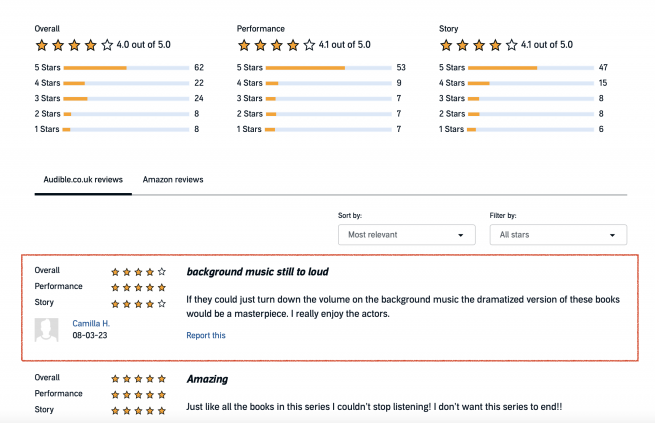
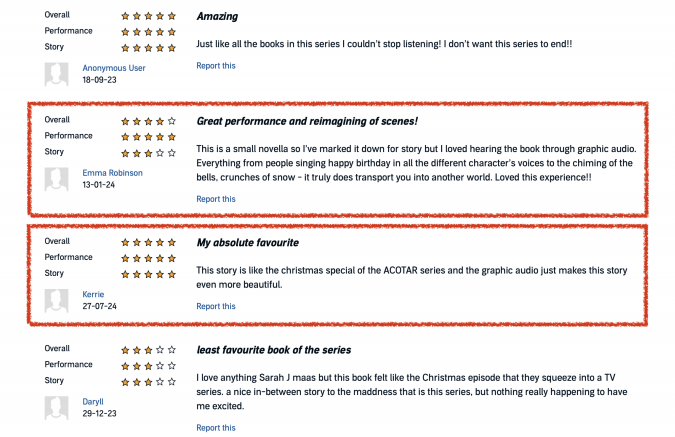
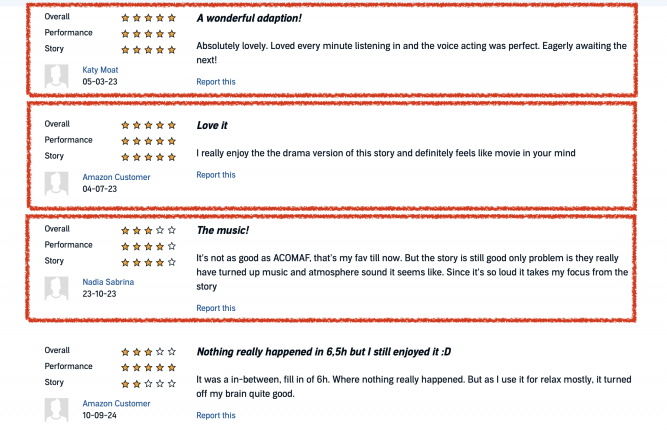
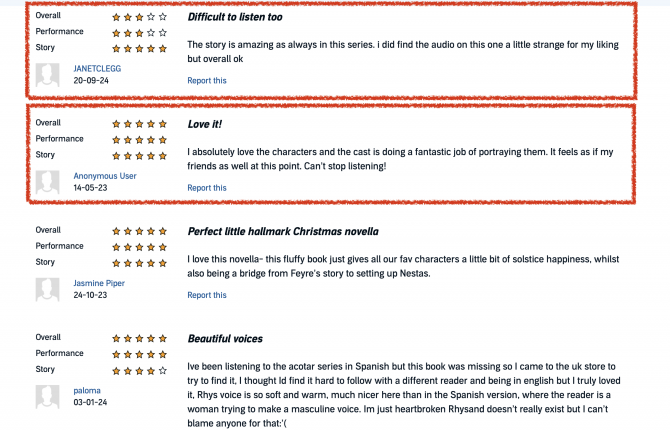
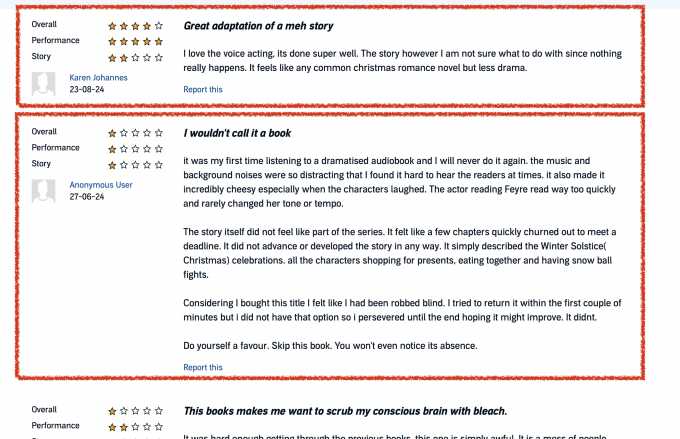
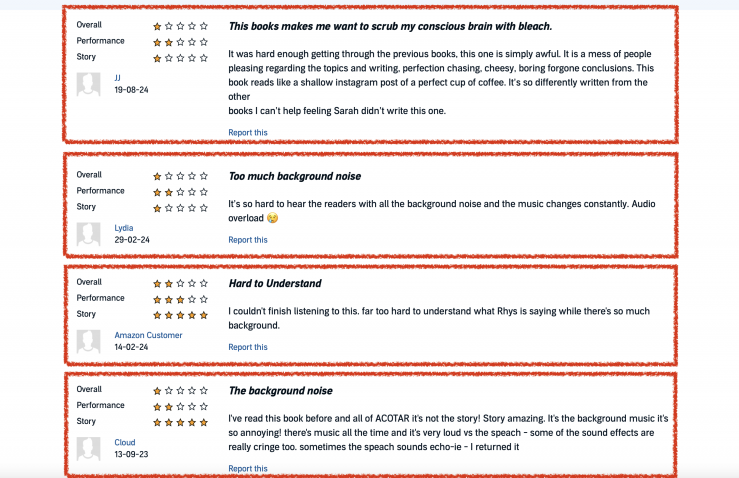
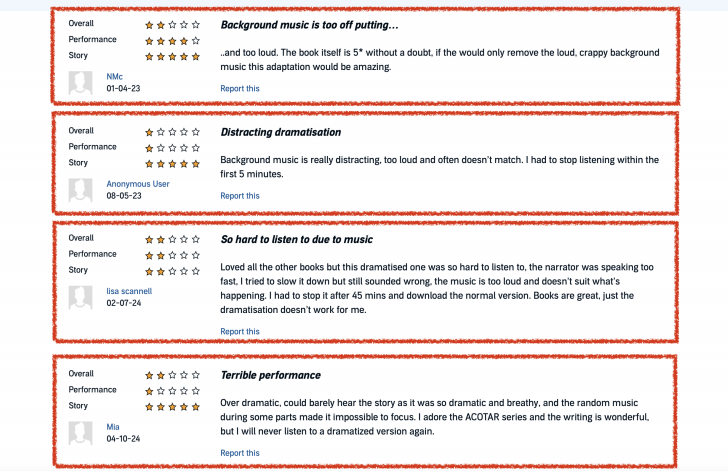
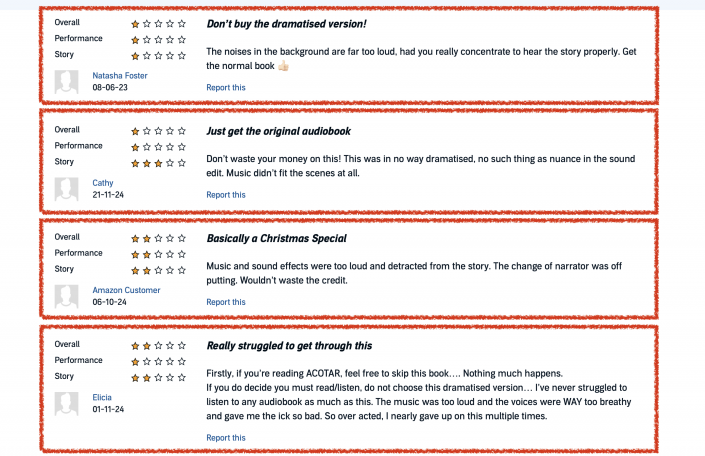
Strengths
- Voice Over Performances
One of the primary strengths of this adaptation lies in the variety of voice overs, due to the full-cast experience. The multiple voices of characters creates an engaging dynamic, helping to bring the story to life. As noted in user reviews, some listeners appreciated this aspect, calling it a “movie in your mind.” The distinct character voices, including the inclusion of telepathic exchanges with reverb, help to differentiate the personalities of the characters and enhance the auditory experience. - Sound Effects
Certain sound effects, like the icy breeze (Cue 9), the clanging of cutlery (Cue 18), or the sound of running water (Cue 23), offer moments of immersive realism. These sound cues, while subtle, provide grounding for the scenes and create a sense of place. For example, the breezes conjure the cold, magical atmosphere of the world, aligning with the fantasy genre’s hallmark focus on environment. - Ambience and Environmental Sound
Many of the sound effects, particularly the soft, airy winds (Cue 13 and 24), contribute to the establishment of mood and location. These moments, though brief, create a sense of space, and when not overshadowed by excessive music or loud sound effects, they could allow the listener to imagine themselves within the world of the story.
Weaknesses
- Underscore: Volume, Repetition, and Appropriateness
One of the most glaring weaknesses of this adaptation lies in the underscoring. The electric piano piece (Cue 4 and 26), which is loud, repetitive, and poorly timed, detracts from the experience rather than enhances it. The music is almost as loud as the voice overs themselves, causing an imbalance in the auditory experience that some listeners found overwhelming and uncomfortable. The repeated use of the same, simple major-key melody, which does not seem to align with the emotional shifts or pacing of the narrative, creates a sense of inconsistency. Ideally, underscoring should be atmospheric, subtle, and nuanced, adjusting to the ebb and flow of the story’s emotional and narrative arcs. In this case, the music’s overly simplistic and dissonant tone often felt misplaced and distracting. - Voice Over Quality and Delivery
Another area where the adaptation falls short is the quality of some voice performances. While the full-cast approach is commendable, the delivery of certain lines leaves much to be desired. The main narrator’s pacing was called out by listeners as too quick, with some noting the voice was “breathy” and “echo-y.” When a narrator speaks too quickly without adjusting their tone or tempo to match the emotional weight of the scene, it can cause the listener to feel disconnected or rushed. This might have contributed to the criticism that the audiobook felt “cringe” or awkward to some listeners, particularly those who are more accustomed to a more measured, emotive and traditional style of narration. - Balance Between SFX, Underscore, and Voice Overs
A key issue highlighted in the feedback is the overwhelming nature of the sound design. The volume of the underscore, combined with the voice overs and narration created an imbalance. A well-done dramatisation needs to carefully balance these elements to avoid sonic fatigue. A loud, persistent background score, coupled with crucial voice over narration that is hard to hear, can make it difficult for the listener to focus on the story itself. Many users complained that the soundtrack often overshadowed the dialogue, causing frustration. This reveals the crucial need for precise mixing and thoughtful integration of sound to maintain the immersion without overwhelming the listener.
Conclusion
Reflecting on the strengths and weaknesses of this adaptation, it becomes clear that achieving a balance between sound effects, underscoring, and voice overs is essential for creating an immersive experience. The underscore should support the narrative’s emotional cadence, rather than dominate the listener’s attention. The use of music is overly simplistic and poorly integrated, causing distraction rather than enhancing immersion. And most importantly, the voice acting needs to be dynamic enough to maintain the emotional engagement of the listener while avoiding unnatural pacing or overly breathy delivery.
In the case of A Court of Frost and Starlight, the balance was not achieved. The loud, repetitive music detracted from the otherwise promising full-cast performances. Moving forward, a more nuanced approach to sound design—one that takes into account the pacing of the story, the emotional tone of the scenes, and the role of the characters—would greatly enhance the immersive quality of the audiobook.
Bibliography
Audible. “A Court of Frost and Starlight (Dramatized Adaptation).” Audible, Graphic Audio LLC, 1 Mar. 2023, www.audible.co.uk/pd/A-Court-of-Frost-and-Starlight-Dramatized-Adaptation-Audiobook/B0BVGSDMZR?qid=1732526299&sr=1-35&ref_pageloadid=rVPKI2EROv80Wdve&pf_rd_p=c6e316b8-14da-418d-8f91-b3cad83c5183&pf_rd_r=NY35JVV0660E717YVGY1&plink=zGiNP3lLYGTlZNZW&pageLoadId=DZt6ONJZJntqIQjn&creativeId=41e85e98-10b8-40e2-907d-6b663f04a42d&ref=a_search_c3_lProduct_2_15. Accessed 25 Nov. 2024.
Maas, Sarah J. Court of Frost and Starlight. Bloomsbury, 2019.